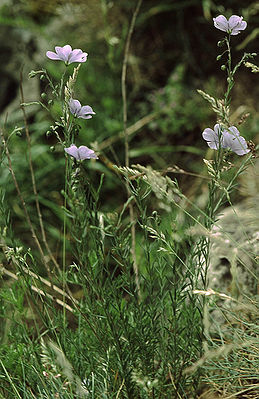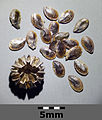Austrian flax
| Austrian flax | ||||||||||||
|---|---|---|---|---|---|---|---|---|---|---|---|---|

Austrian flax ( Linum austriacum ) |
||||||||||||
| Systematics | ||||||||||||
|
||||||||||||
| Scientific name | ||||||||||||
| Linum austriacum | ||||||||||||
| L. |
The Austrian flax or Austrian flax ( Linum austriacum ) is a member of the linaceae (Linaceae) that is scattered or rarely found in Central Europe on the colline and partly montane elevations .
Appearance
The perennial herbaceous plant reaches a height of about 30 to 60 cm. It resembles the perennial flax ( Linum perenne ) in its appearance . The shoot is usually upright, rarely ascending and richly branched. The stem leaves are linear-lanceolate in shape and have no eyelashes. The sepals are egg-shaped and pretty much the same length. They are shorter than the spherical-egg-shaped capsule . The inner sepals are very obtuse. The inflorescence is a thyrsus , the partial inflorescences are formed as coils and multi-flowered. The petals are colored azure. The main differences to Linum perenne are the horizontally protruding to downwardly curved fruit stalks and the difference between the outer and inner sepals, which is only 0 to 0.3 mm in Linum austriacum , while it is 0.3 to 0.6 mm in Linum perenne are.
The flowers are usually only open in the morning. It blooms from May to July, sometimes until September.
The number of chromosomes is 2n = 18.
distribution
Location requirements
Linum austriacum grows in dry summer grass and on dry railway embankments. It prefers stony and mostly calcareous substrates. In Central Europe it is a character species of the Cirsio-Brachypodion association, but also occurs in societies of the Dauco-Melilotion association.
General distribution
The original homeland of Linum austriacum is the Middle East. The Austrian flax was first recorded in Germany in 1860 from Thuringia. It was presumably anointed or brought in with seeds. Since then the species has been wild and spreading further. Today the Austrian flax occurs in the Middle East to Central and Southeast Europe. In Switzerland it is generally rare, but often occurring in advent . It is an east-sub-Mediterranean floral element.
Distribution in Austria
In Austria it occurs scattered in the Pannonian area , otherwise rarely (probably only naturalized) in the federal states of Burgenland , Vienna , Lower Austria and Carinthia (naturalized in Upper Austria , Styria , Salzburg and Tyrol ). The species is considered endangered.
Distribution in Germany
Linum austriacum is only found scattered or rarely in the central part of Germany. In addition, it is partly overgrown from culture and naturalized in places.
Historical use
Flax was used very early in ancient Egypt , initially the fiber was obtained from common flax ( Linum usitatissimum ), since 4000 BC. Austrian flax was increasingly used, which has been in use since at least 2500 BC. Was cultivated there.
Species protection
Endangerment in Germany: Category 3: endangered!
The species is particularly protected according to BArtSchV !
photos
literature
- Henning Haeupler , Thomas Muer: picture atlas of the fern and flowering plants of Germany (= the fern and flowering plants of Germany. Volume 2). Published by the Federal Agency for Nature Conservation. Ulmer, Stuttgart 2000, ISBN 3-8001-3364-4 .
- Manfred A. Fischer , Karl Oswald, Wolfgang Adler: Excursion flora for Austria, Liechtenstein and South Tyrol. 3rd, improved edition. State of Upper Austria, Biology Center of the Upper Austrian State Museums, Linz 2008, ISBN 978-3-85474-187-9 .
- August Binz , Christian Heitz: School and excursion flora for Switzerland , Schwabe & Co. AG, Basel, 1986, ISBN 3-7965-0832-4
- Erich Oberdorfer : Plant-sociological excursion flora , Ulmer Verlag, Stuttgart 1990, ISBN 3-8001-3454-3
- Christian August Friedrich Garcke : Illustrierte Flora , 1972, Paul Parey publishing house, ISBN 3-489-68034-0
Individual evidence
- ↑ a b Erich Oberdorfer : Plant-sociological excursion flora for Germany and neighboring areas . 8th edition. Verlag Eugen Ulmer, Stuttgart 2001, ISBN 3-8001-3131-5 . Page 632.
- ↑ Masoud Sheidai, Fatima Afsharb, Maryam Keshavarzib, Seyed-Mehdi Talebic, Zahra Noormohammadid, Tina Shafaf: Genetic diversity and genome size variability in Linum austriacum (Lineaceae) populations. In: Biochemical Systematics and Ecology , Volume 57, 2014, pp. 20-26, doi : 10.1016 / j.bse.2014.07.014 .
- ^ Jun-suk Kang: A history of textiles in Egypt. Term paper, 2009.
Web links
- Austrian flax. In: FloraWeb.de.
- Profile and distribution map for Bavaria . In: Botanical Information Hub of Bavaria .
- Linum austriacum L. In: Info Flora , the national data and information center for Swiss flora . Retrieved November 29, 2015.
- Thomas Meyer: Data sheet with identification key and photos at Flora-de: Flora von Deutschland (old name of the website: Flowers in Swabia )
- Data sheet for the Austria flax at Botany in the picture - Flora of Austria





